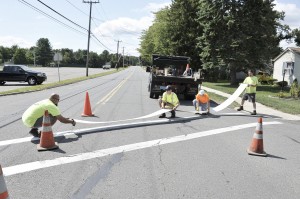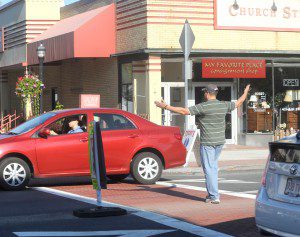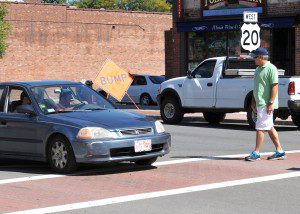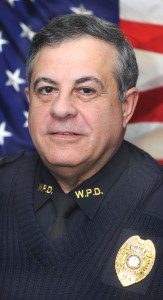
Employees from the Southwick Highway Department apply a reflective adhesive strip to mark the crosswalk at the Powder Mill School last August. The reflective strip replaced the conventional paint method of marking the crosswalk with paint. (WNG file photo)
WESTFIELD – The Traffic Commission discussed the standardization of cross walk design throughout the city to increase the awareness of motorists and the safety of pedestrians using crosswalks.
Highway Division foreman Joel Faria said there are three crosswalk patterns approved by the Massachusetts Executive Office and Transportation and the Federal Highway Administration.

Plainclothes officer Steven Nacewicz gestures at a driver who failed to stop as he was crossing Elm Street in a crosswalk in 2012. Officers were conducting the first of a series of enforcement efforts at city crosswalks. (File photo by Carl E. Hartdegen)
“I’m trying to standardize crosswalks in the city because right now we have all three styles accepted by the state and the Federal Highway Administration,” Faria said.
Faria said he is requesting the Traffic Commission to adopt a standard pattern because the Highway Division is considering using an alternative to paint which has to be replaced every six months to a year and cannot be used during the colder months of the year.
The Highway Division “is looking to get into something different, preformed thermal plastic which is melted onto the road, so it can be applied during cold weather,” Faria said.
The thermal plastic is more expensive than paint, but lasts about five to seven years, which makes if a viable option economically, Faria said.
Traffic Commissioner Brian Boldini, a retired city police officer who served as the supervisor of the department’s Traffic Bureau, said that while he was with the Police Department he petitioned the DPW to use the ladder crosswalk design because of its greater visibility.
The other two approved designs are the two parallel lines across the roadway, the minimal requirement and the zebra of diagonal striping.
“I like them (the ladder pattern) because you, as a motorist approaching the crosswalk, can see them at a distance,” Boldini said. “I think that creates more safety for pedestrians if motorists can see the crosswalk lines.”
“Motorists often cannot see the lines in the case of the parallel pattern,” Boldini said.
DPW director Dave Billips suggested that reflective lines be used and argued that just the two parallel lines are more cost effective.
“The ladder design is expensive, so you replace fewer each year,” Billips said, suggesting “that we test in a few spots before our next (Traffic Commission) meeting.”
Police Chief John Camerota, chairman of the commission, said that the “our concern is safety, not expense” then requested a motion to “do a couple of tests with different patterns to see what they look like.”
“Put a couple of crosswalks in high traffic locations, then we’ll look at them and have further discussion,” Camerota said.
In other business Robert Bolduc came before the commission to discuss the traffic issues related to the Pride construction proposal for the “jug handle” across from the Massachusetts Turnpike.
Commission Thomas Liptak had requested that agenda item.
“My main reason of concern is that there will be an entrance at the beginning of the jug handle into your facility and traffic coming up Clay Hill (North Elm Street) is already in a bottle neck which will only get worse,” he said.
Bolduc said that VHB, the engineering firm doing the traffic impact information for the Pride project, had initiated a traffic count on Southampton Road, but that the Planning Board had requested that the traffic count be performed when Westfield State University and the city schools are in session next fall.
“We’re nowhere near completion on that project,” Bolduc said. “We’re starting (the traffic impact study) all over and so is the DOT. The traffic count has been postponed until the fall.”





